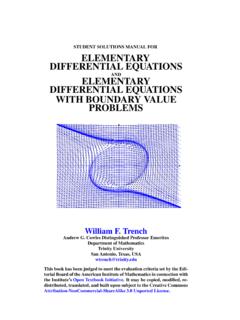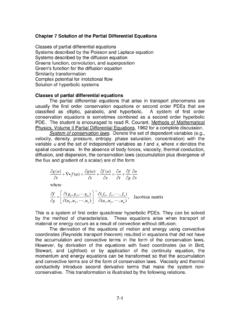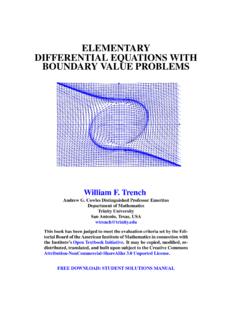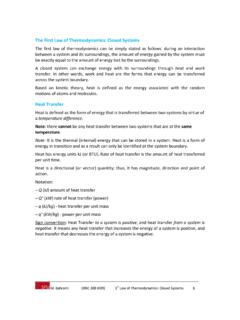Transcription of 1 Introduction. - MIT
1 1. I-campus project School-wide Program on Fluid Mechanics Modules on High Reynolds Number Flows K. P. Burr, T. R. Akylas & C. C. Mei CHAPTER TWO. TWO-DIMENSIONAL LAMINAR boundary LAYERS. 1 introduction . When a viscous fluid flows along a fixed impermeable wall, or past the rigid surface of an immersed body, an essential condition is that the velocity at any point on the wall or other fixed surface is zero. The extent to which this condition modifies the general character of the flow depends upon the value of the viscosity.
2 If the body is of streamlined shape and if the viscosity is small without being negligible, the modifying effect appears to be confined within narrow regions adjacent to the solid surfaces; these are called boundary layers. Within such layers the fluid velocity changes rapidly from zero to its main-stream value, and this may imply a steep gradient of shearing stress;. as a consequence, not all the viscous terms in the equation of motion will be negligible, even though the viscosity, which they contain as a factor, is itself very small.
3 A more precise criterion for the existence of a well-defined laminar boundary layer is that the Reynolds number should be large, though not so large as to imply a breakdown of the laminar flow. 2 boundary Layer Governing Equations. In developing a mathematical theory of boundary layers, the first step is to show the existence, as the Reynolds number R tends to infinity, or the kinematic viscosity . tends to zero, of a limiting form of the equations of motion, different from that obtained by putting = 0 in the first place.
4 A solution of these limiting equations may then reasonably be expected to describe approximately the flow in a laminar boundary layer 2. for which R is large but not infinite. This is the basis of the classical theory of laminar boundary layers. The full equation of motion for for a two-dimensional flow are: 2. u 2u . u u u 1 p +u +v = + + , ( ). t x y x x2 y 2. 2. v 2v . v v v 1 p +u +v = + + , ( ). t x y y x2 y 2. u v + = 0, ( ). x y where the x and y variables are, respectively, the horizontal and vertical coordinates, u and v are, respectively, the horizontal and vertical fluid velocities and p is the fluid pressure.
5 A wall is located in the plane y = 0. We consider non-dimensional variables x x0 = , ( ). L. 0 y y = , ( ).. 0 u u = , ( ). U. vL. v0 = , ( ). U . p p0 = 2 , ( ). U. U. t0 =t , ( ). L. where L is the horizontal length scale, is the boundary layer thickness at x = L, which is unknown. We will obtain an estimate for it in terms of the Reynolds number R. U is the flow velocity, which is aligned in the x-direction parallel to the solid boundary . The non-dimensional form of the governing equations is: u0 0 u 0.
6 0 u 0. p0 2 u0 L2 2 u 0. +u 0 +v 0 = 0 + + , ( ). t0 x y x U L (x0 )2 U L 2 (y 0 )2. 2 0 2 2 0. v 0 0 v 0. 0 v 0. L p 2v0 L v 0. +u 0 +v 0 = 0. + 0. + , ( ). t x y y U L (x ) 2 UL (y 0 )2. u0 v 0. + = 0, ( ). x0 y 0. 3. where the Reynolds number for this problem is UL. R= . ( ).. Inside the boundary layer, viscous forces balance inertia and pressure gradient forces. In other words, inertia and viscous forces are of the same order, so 2. L. = O(1) = O(R 1/2 L). ( ). UL . Now we drop the primes from the non-dimensional governing equations and with equa- tion ( ) we have u u u p 1 2u 2u +u +v = + + , ( ).
7 T x y x R x2 y 2. 1 2v 2v . 1 v v v p +u +v = + + , ( ). R t x y y R2 x2 y 2. u v + = 0. ( ). x y In the limit R , the equations above reduce to: u u u p 2 u +u +v = + , ( ). t x y x y 2. p = 0, ( ). y u v + = 0. ( ). x y Notice that according to equation ( ), the pressure is constant across the boundary layer. In terms of dimensional variables, the system of equations above assume the form: u u u 1 p 2u +u +v = + 2, ( ). t x y x y 1 p = 0, ( ). y u v + = 0. ( ). x y 4. To solve the system of equations above we need to specify initial and boundary conditions.
8 3 Steady State Laminar boundary Layer on a Flat Plate. We consider a flat plate at y = 0 with a stream with constant speed U parallel to the plate. We are interested in the steady state solution. We are not interested in how the flow outside the boundary layer reached the speed U . In this case, we need only to u consider boundary conditions and the equation ( ) simplifies since t = 0. At the plate surface there is no flow across it, which implies that v = 0 at y = 0. ( ). Due to the viscosity we have the no slip condition at the plate.
9 In other words, u = 0 at y = 0. ( ). At infinity (outside the boundary layer), away from the plate, we have that u U as y . ( ). For the flow along a flat plate parallel to the stream velocity U , we assume no pressure gradient, so the momentum equation in the x direction for steady motion in the boundary layer is u u 2u u +v = 2 ( ). x y y and the appropriate boundary conditions are: 5. At y = 0, x > 0;u = v = 0, ( ). At y , all x;u = U, ( ). At x = 0;u = U. ( ). These conditions demand an infinite gradient in speed at the leading edge x = y = 0, which implies a singularity in the mathematical solution there.
10 However, the assump- tions implicit in the boundary layer approximation break down for the region of slow flow around the leading edge. The solution given by the boundary layer approximation is not valid at the leading edge. It is valid downstream of the point x = 0. We would like to reduce the boundary layer equation ( ) to an equation with a single dependent variable. We consider the stream function related to the velocities u and v according to the equations . u= , ( ). y . v = . ( ). x If we substitute equations ( ) and ( ) into the equation ( ), we obtain a partial differential equation for , which is given by 2 2 3.















